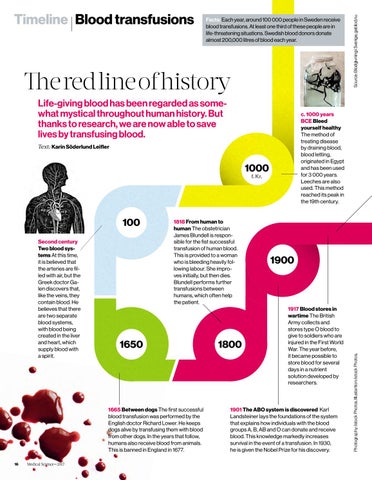The red line of history Life-giving blood has been regarded as somewhat mystical throughout human history. But thanks to research, we are now able to save lives by transfusing blood.
c. 1000 years BCE Bleed yourself healthy The method of treating disease by draining blood, blood letting, originated in Egypt and has been used for 3 000 years. Leeches are also used. This method reached its peak in the 19th century.
Text: Karin Söderlund Leifler
1000 f. Kr.
100 Second century Two blood systems At this time, it is believed that the arteries are filled with air, but the Greek doctor Galen discovers that, like the veins, they contain blood. He believes that there are two separate blood systems, with blood being created in the liver and heart, which supply blood with a spirit.
1818 From human to human The obstetrician James Blundell is responsible for the fist successful transfusion of human blood. This is provided to a woman who is bleeding heavily following labour. She improves initially, but then dies. Blundell performs further transfusions between humans, which often help the patient.
1650
1665 Between dogs The first successful blood transfusion was performed by the English doctor Richard Lower. He keeps dogs alive by transfusing them with blood from other dogs. In the years that follow, humans also receive blood from animals. This is banned in England in 1677. 16
Medical Science–2017
1800
Source: Blodgivning i Sverige, geblod.nu
Facts: Each year, around 100 000 people in Sweden receive blood transfusions. At least one third of these people are in life-threatening situations. Swedish blood donors donate almost 200,000 litres of blood each year.
1900
1917 Blood stores in wartime The British Army collects and stores type O blood to give to soldiers who are injured in the First World War. The year before, it became possible to store blood for several days in a nutrient solution developed by researchers.
1901 The ABO system is discovered Karl Landsteiner lays the foundations of the system that explains how individuals with the blood groups A, B, AB and O can donate and receive blood. This knowledge markedly increases survival in the event of a transfusion. In 1930, he is given the Nobel Prize for his discovery.
Photography: Istock Photos. Illustartion: Istock Photos.
Timeline Blood transfusions
